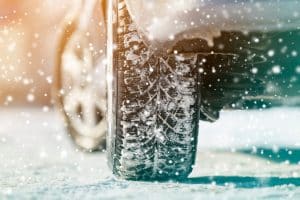How Dangerous Is Winter Driving in ND? Depends Who You Ask
 The snow is officially here. If you grew up in North Dakota, we know that you know what it’s like to drive in snow, ice, and sleet; it comes with the territory (literally). But we saw an article recently that said we’re one of the worst states in the nation for winter driving, and truth be told – we have some questions.
The snow is officially here. If you grew up in North Dakota, we know that you know what it’s like to drive in snow, ice, and sleet; it comes with the territory (literally). But we saw an article recently that said we’re one of the worst states in the nation for winter driving, and truth be told – we have some questions.
The consumer website Clearsurance gathered and analyzed data from the National Highway Traffic Safety Administration (NHTSA) and the Federal Highway Administration (FHWA) to determine their top 10 states with the most fatal winter car accidents.
North Dakota comes in at number two, next to only Wyoming, and the entire list is as follows:
- Wyoming
- North Dakota
- Nebraska
- Vermont
- Alaska
- Montana
- Maine
- Iowa
- South Dakota
- Michigan
North Dakota had 19.6 fatal motor vehicle accidents for every one million drivers. Nationwide, the average number of crashes in winter weather is only 4.3 per million drivers.
So – what’s the takeaway here? It’s not that we can’t drive in snow and ice; we’re basically raised knowing how to do that. Why, then, are our numbers so high, according to this one insurance company?
No small part of it is the number of people who live here. A rough estimate puts our state population at around 775,000 people, so any deaths are likely to skew the average. (Wyoming has even fewer residents, so no surprise it’s in the top spot).
The other likely reasons include:
- Out-of-state drivers who may not be prepared for road conditions. Long-haul truckers, for example, may start off in cold but mild weather and find themselves in the middle of blizzard. If their trucks aren’t outfitted for the weather (assuming, of course, that they stay put until the storm ends), they could be in trouble.
- Obscured lanes and rumble strips. KYYR reports that about 75% of all fatal crashes in North Dakota in the last five years are lane departure accidents. NDDOT has put in rumble strips and warning signs, but both can be obscured by wind, fog, precipitation, and ice. All it takes is one little slip on ice to find yourself in a rollover crash.
We’re not saying that driving in snow isn’t dangerous; it is. What we’re saying is that if you live here, you already know it’s dangerous. But if you’re new to the area, passing through on your way elsewhere, or have a teenager at home who’s about to take the wheel for the first time, well – a little review never hurt anyone.
First winter driving in Minot? Here’s a checklist
Understanding how to handle your vehicle in winter weather can help you avoid those drivers that don’t – or at least potentially help you escape an accident without severe injury.
The Clearsurance article offers a list of everything drivers should check in their vehicles for safe winter driving:
- Tires. Ensure you have good, safety-rated winter tires with a good tread. You’ll need the traction on slippery surfaces.
- Battery. Your vehicle’s battery works overtime in the winter, so it’s important to make sure it’s in good working order before you embark on your trip. Check for loose, damaged, or oxidized wires and connections.
- Oil and coolant. Make sure your fluid levels are correct, there are no leaks, and your oil has been recently changed.
- Windshield wipers. Ensure your wiper blades are working well (replace if necessary) and your wiper fluid is full.
- Brakes. Cold temperatures can make your brakes and pads wear out more quickly. Be alert for any changes or losses in your braking system and have them taking care of immediately.
- Heating. If your heating system doesn’t work, your windshield can begin freezing, causing visibility issues.
- Fuel. Experts advise not letting your gas tank fall below half-full during freezing temperatures.
Experts also recommend carrying the following tools in your vehicle during colder months in case of an emergency: A brush with a scraper, a shovel, jumper cables, extra fuel, a lock defroster, gloves and a flashlight, and a warm blanket. Consider getting one of those emergency hammer and belt cutter tools, too. They really can save lives.
The North Dakota Department of Transportation (NDDOT) also offers its own guidance for winter traveling. They urge motorists to “Know Before You Go” by calling 511 to check road conditions. They also note to never use automated technologies like cruise control on wet or icy roadways, and to double your distance when following other vehicles to allow more braking time.
Another extremely important point they make: “If your vehicle becomes stuck in a snowstorm, stay with the vehicle! Most deaths occur when people leave their vehicles and get lost. Open your windows slightly and run the vehicle and heater for only short periods of time to avoid carbon monoxide poisoning. Stay active and do not panic.”
After a winter weather car accident
If you do end up involved in a car accident during snowy or icy weather, take a few steps to protect yourself and your potential legal claim. Often in these types of accidents, the negligent party may attempt to blame the weather or road conditions for the crash. However, this is rarely the primary cause. The other driver is usually driving too fast for the weather conditions or otherwise at fault for the accident.
If possible, try to get photos or videos at the scene, as snow and ice may soon cover up skid marks and other evidence from the crash. This includes photos of the damage to both vehicles as well. Ensure you receive prompt medical attention for your injuries, and talk to an experienced personal injury attorney as soon as possible so they can begin an investigation into your claim.
An attorney works to hold the at-fault driver accountable for their negligent actions. After you suffer injury in a car accident, your attorney works to secure compensation for those injuries and losses – for your medical expenses, for your lost wages, for your pain and suffering, and for everything you went through due to another driver’s negligence.
Talk to Larson Law today for skillful and reliable representation after a car or truck accident. With offices in Bismarck, Minot, and Fargo, we’re here for clients throughout North Dakota when they need help. To find out how we can help you secure financial compensation after an accident or injury that wasn’t your fault, call us today in Minot or fill out our contact form to schedule an appointment.

Mark Larson is a Certified Civil Trial Specialist and Certified Civil Pre-Trial Specialist focusing on personal injury, car accidents, wrongful death, and oil field claims. Since 1979, Larson Law has served the injured throughout North Dakota. Read more about Mark V. Larson.
